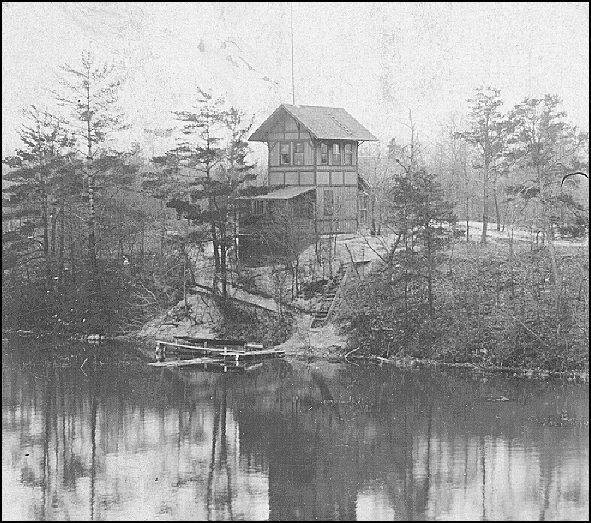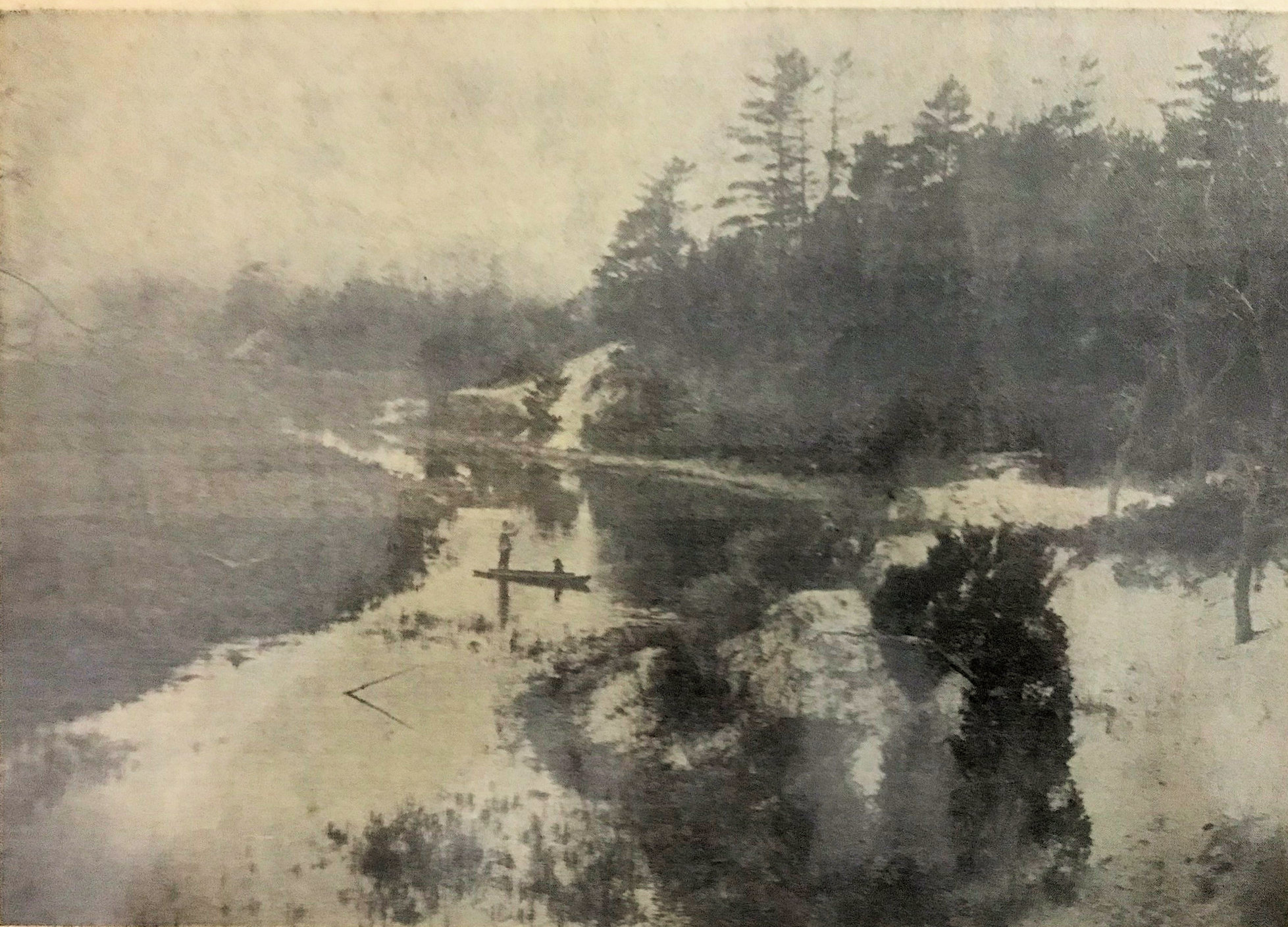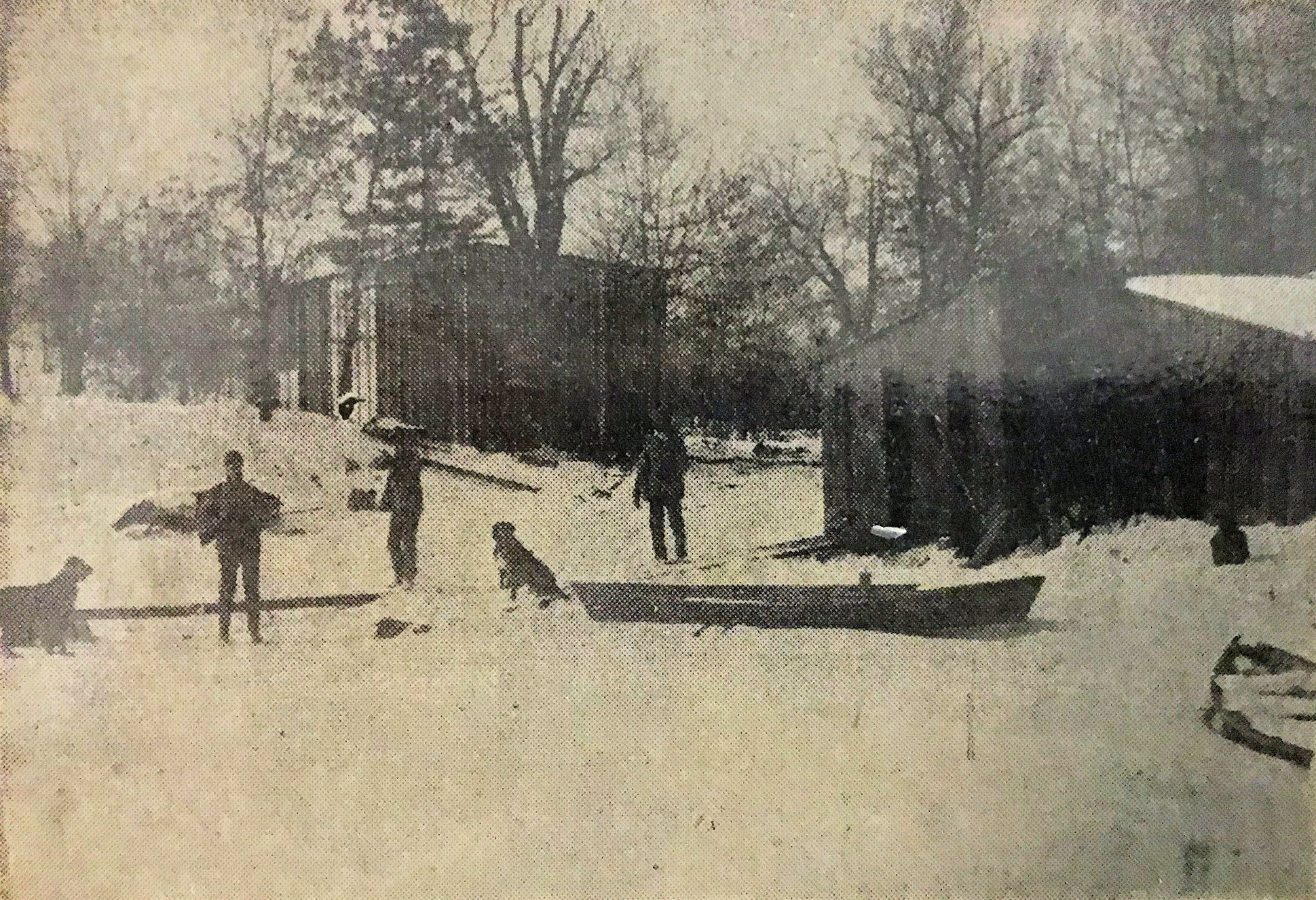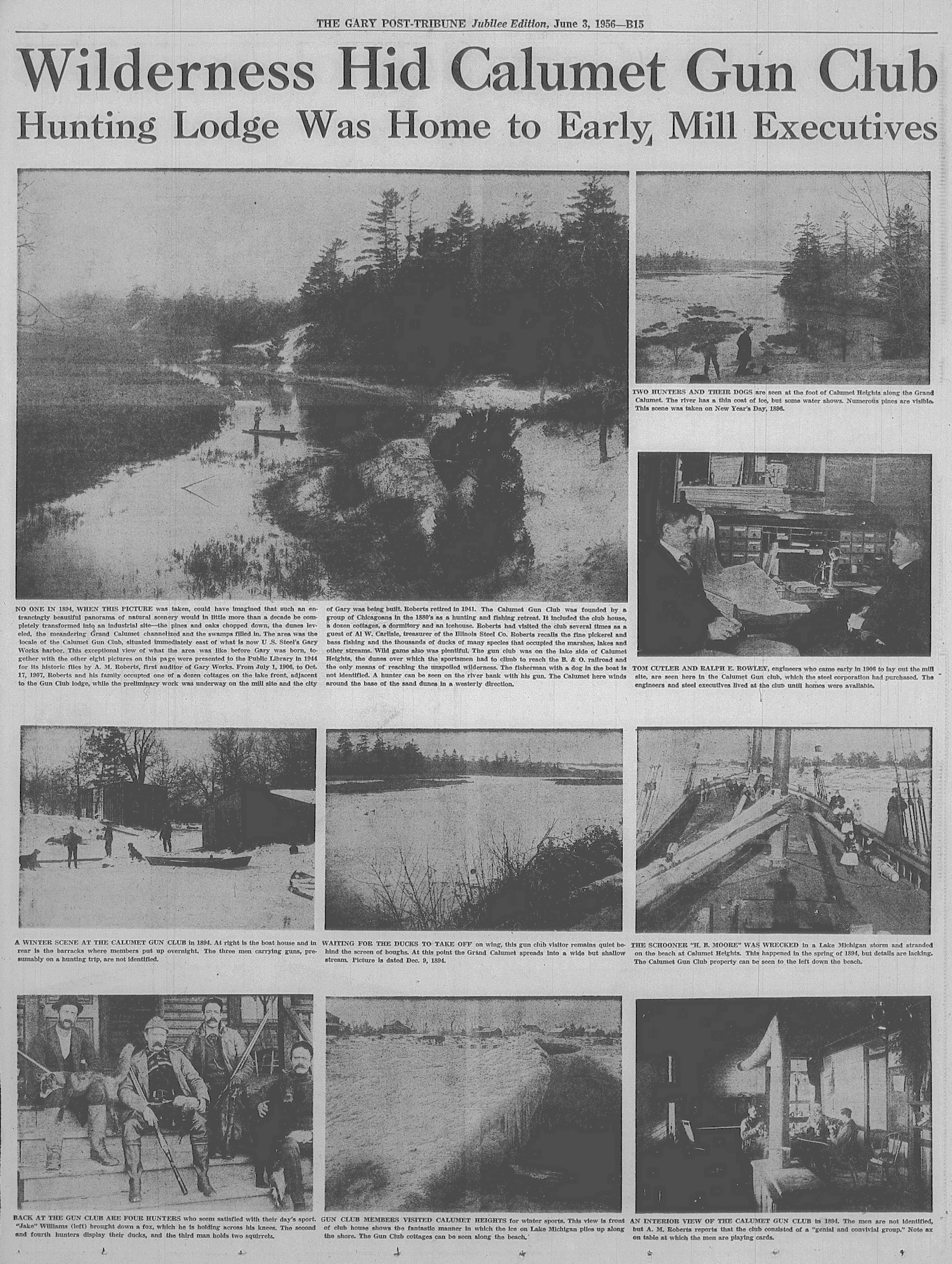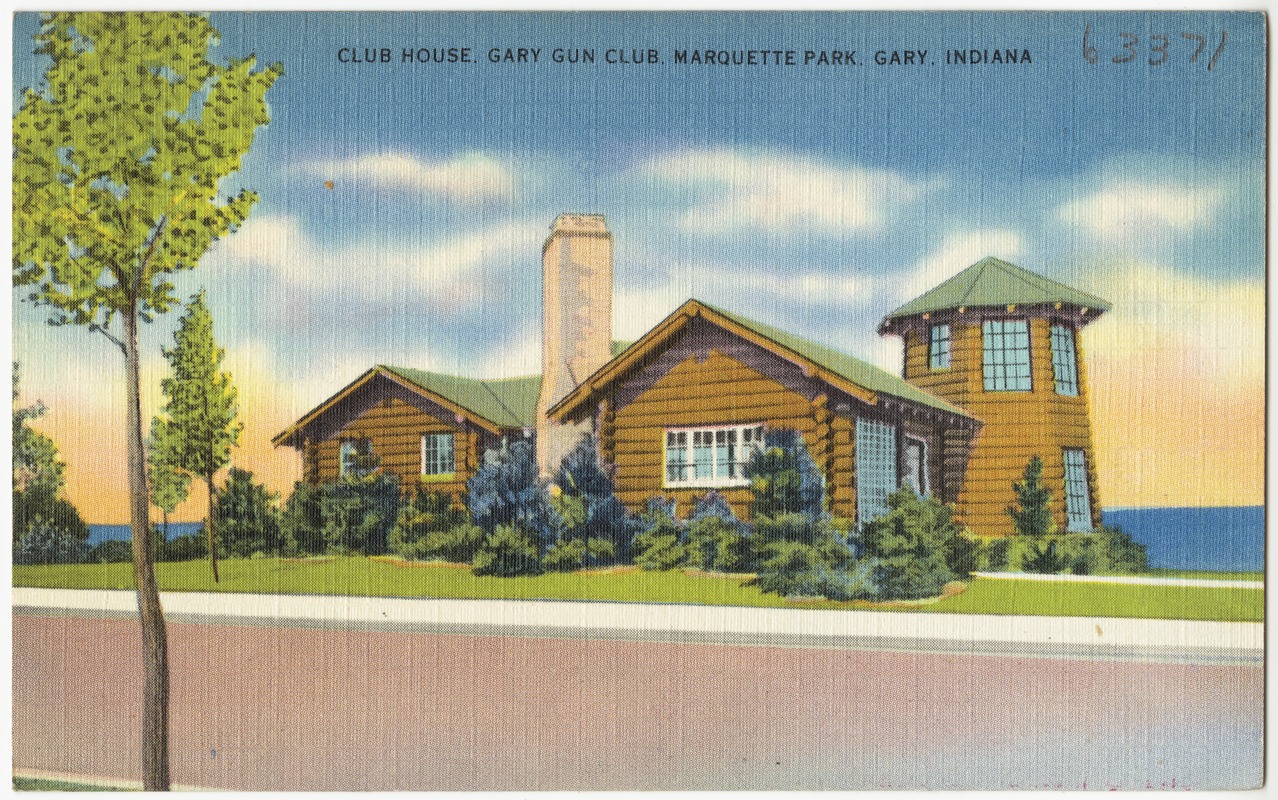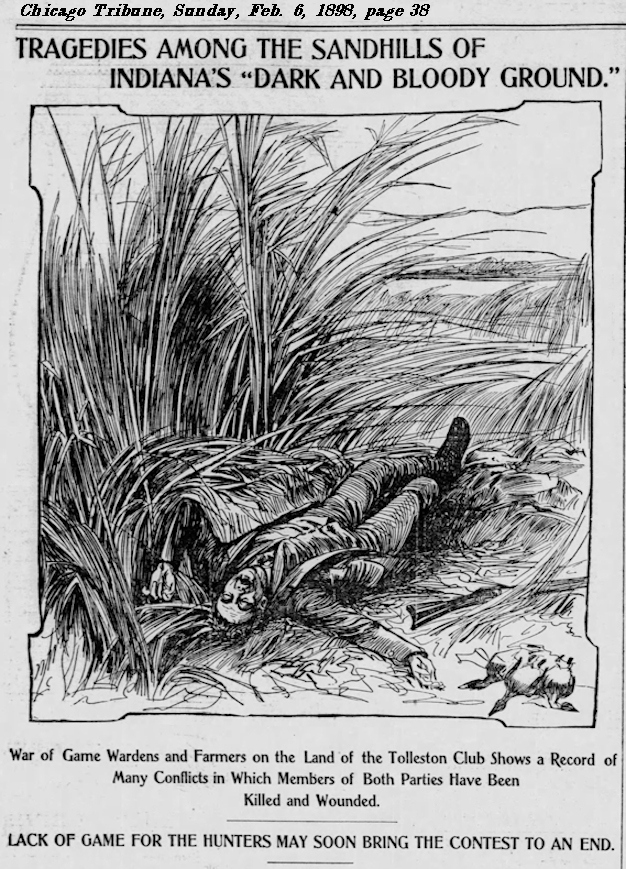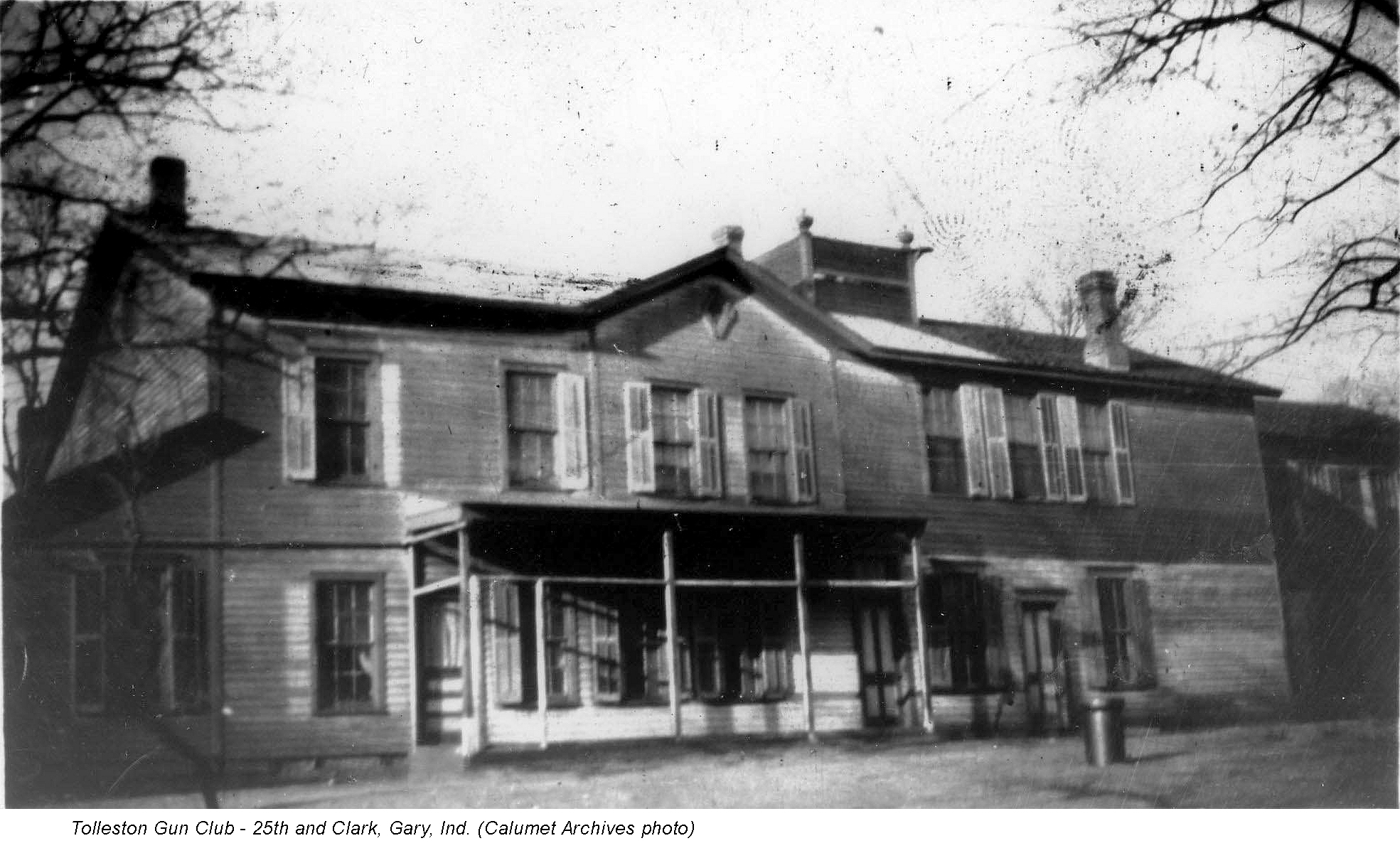Early Gun Clubs of Northwest Indiana
Miller Gun Club, Calumet Gun Club, Gary Gun Club, and Tolleston Gun Club
Before the mills the region south of Lake Michigan abounded with wildlife of all types. Anyone who has seen the marvelous documentary Everglades of the North
will have an appreciation for that; along the Grand Calumet, and all along the south end of Lake Michigan the wildlife, and the proliferation of gun clubs was similar to the what
was going on along the Kankakee marsh.
Hunting was a source of food for Native Americans, and also for many of the new settlers who began filtering into the wetlands of northwest Indiana during the nineteenth century. Hunting for food was replaced by "sportsmen" as the game disappeared and populations increased; trap, or skeet, shooting became the primary occupation of the later gun clubs. This page will explore four of the clubs that were in Miller and Gary.
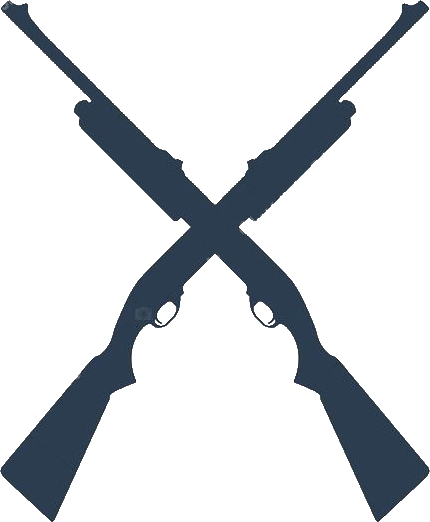
The Miller Gun Club 1903-1915
Anyone looking through the pictures in the foyer of the Aquatorium may have seen this photo on the left but not known what it was. The structure, which began as the signaling tower at the crossing of the B&O railroad and Lake Shore and Michigan Southern at Lake street and Miller avenue, was moved in 1903 north to the lagoon where it took up residence as the Miller Gun club. William Westergren, the colorful judge and sand company superintendent, leased the tower from the railroad and moved it to where it would become home to the Miller Gun club. When it burned down in 1915 its obituary in The Times said that it stood on the south bank of the Grand Calumet, a short distance east of Lake street, then a gravel road.
This marvelous picture, from Jean Buckley via Ken Schoon, has in the upper left what is written on the back of the photo.
.jpg)
This photo has the image overlaid on "Junction photo" that is about 1895-1900.
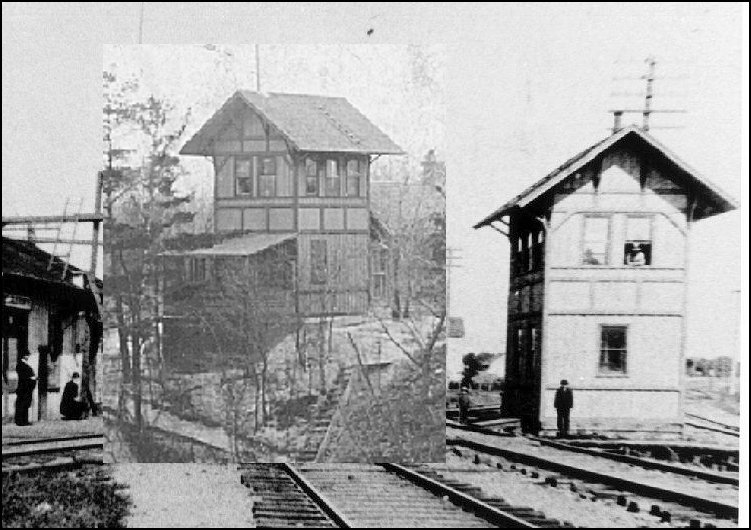
Click here to see
the 1895-1900 "Junction Photo" by itself.
As obscure is the Miller Gun Club is, perhaps more so is the Aetna Shooting and Fishing Club in Miller. On September 27, 1897 the Huntington, Indiana Daily News-Democrat reported the club, composed mostly of owners and employees of the Aetna Powder company of Chicago, would build a lodge in Miller station. Prominent Hammond builder, Gustave Muenich, was to build the lodge for $4,000.00 in 30 days. I've never found anything more about this.
The Calumet Gun Club
As elusive as the previous is the Calumet Gun Club that operated from the late 1880s to 1906 on land which is now the east side of U.S. Steel's Gary works. One good source about this club is a full page of pictures, with the captions, that was printed in the Gary Post-Tribune's Golden Jubilee editions in the spring and early summer of 1956. Another good source is an article published in Forest and Stream magazine in its June 27, 1896 number which describes the club as:
"...one of the very ablest and strongest of the Chicago outdoor clubs to-day, but it is not alone in shooting matters that it excels. Its delightful grounds, on the beach of Lake Michigan, deep in the wild sand hill wilderness which makes so interesting a feature of the scenery to the south of this city, attract at the close of each week an attendance of an average of 40 or 50 persons, and on special days sometimes as high as 150...There is no doubt this is the most popular outing club of Chicago, and it is especially famous as a family club. Besides two large club houses there are eight cottages belonging to members, and throughout the summer season these are usually full, for no pleasanter place exists so close to the city to pass a summer day. The surroundings are wild and picturesque, and there are many features of interest denied to the clubs nearer town and necessarily situated among the more common -place environments. At the Calumet Club one is entirely removed from the suggestion of the city, and the sense of privacy is absolute. The wide blue lake which laps the sands at the foot of the target score might as well be the saltsea, and the nets of the local fisher folk, the stranded and wrecked vessels of all descriptions, and the general flotsam and jetsam of the shore bear out the impression of the seashore and make the spot as far removed from Chicago as though a thousand miles separated the on from the other."
These photos, printed in the Golden Jubilee edition, are also very descriptive. Below is the caption to the first photo:
"No one in 1894, when this picture was taken, could have imagined that such a beautiful panorama of natural scenery would in little more than a decade be completely transformed into an industrial site-the pines and oaks chopped down, the dunes leveled, the meandering Grand Calumet channelized and the swamps filled in. The area was the locale of the Calumet Gun Club, situated immediately east of what is now U..S. Steel’s Gary works harbor. This exceptional view of what the area was like before Gary was born, together with the eight other pictures on this page were presented to the Public Library in 1944* of its historic files by A. M. Roberts, first auditor of Gary Works. From July 1, 1906 to Oct. 17, 1907, Roberts and his family occupied one of a dozen cottages on the lake front, adjacent to the Gun Club lodge, while preliminary work was underway on the mill site and the city of Gary was being built. Roberts retired in 1941. The Calumet Gun Club was founded by a group of Chicagoans in the 1880’s as a hunting and fishing retreat. It included the club house, a dozen cottages, a dormitory and an icehouse. Roberts had visited the club several times as a guest of Al W. Carllisle, treasurer of the Illinois Steel Co. Roberts recalls the fine pickerel and bass fishing and the thousand so duck of many species that occupied the marshes, lakes and other streams. Wild game also was plentiful. The gun club was on the lake side of Calumet Heights, the dunes over which the sportsmen had to climb to reach the B. & O. railroad and the only means of reaching the unspoiled wilderness. The fishermen with a dog in the boat is not identified. A hunter can be seen on the river bank with his gun. The Calumet here winds around the base of the sand dunes in a westerly direction."
The lower photo caption is "A WINTER SCENE AT THE CALUMET GUN CLUB in 1894. At right is the boat house and in the rear is the barracks where members put up overnight. The three men carrying guns, presumably on a hunting trip, are not identified."
* These photos are no longer at the Public Library. I've searched for the originals to provide a good scan, but I theorize that the Post-Tribune took them to make the Golden Jubilee edition in 1956 and never returned them. They are likely lost, along with the Tribune photo archive.
To see the full page of photos from the 1956 Jubilee edition of the Post-Tribune click on the image to open it in a new window or tab.
William P. Gleason, who died heralded as "The Father of Gary," being a long time superintendent and park board chairman, recounted very descriptively his first visit to the area on June 1, 1906:
"I have never known a couple of miles that were any longer than the two miles of that sandy wagon path which I trudged over that first afternoon. The path began about where the Michigan Central overhead crosses Tolleston. It cut diagonally from there to what is now West Side Park. It traversed sand knoll and swamp. As I reached a point which is now the park, I came to a little swinging bridge of a “run” (Gibson Run). On the four corners of this bridge there were ropes fastened to sticks driven in the ground. When the water was high the rope fastenings prevented the bridge from floating away. When the water was low the bridge settled into place. From the bridge the path turned slightly northeast until it reached the site of the present Steel Mill Hospital, then to the Calumet Gun Club, which was located about where the National Tube Company is now.” (Calumet Region Historical Guide, Work Projects Administration, 1939, page 154.)
In 1916 it was announced that a new Tube works would be built at that location, but the tube works, the National Tube Company, was not built until 1926.
The cottages and lodges were not demolished until later; hunting and fishing came to an end with the massive activity of the steel mill. In July of 1909 The Times ran an article that about 30 young couples celebrated the Fourth of July in the cottages of the old Calumet Gun club. The lodges were finally removed in 1914; on July 3rd The Daily Tribune noted on page one that "The group of pretty cottages of Gary's oldest landmark is passing." The article goes on to say that the buildings had stood deserted for years, windows shattered and walls with big holes in them. They were purchased, torn down and/or moved to Miller beach. Tony Carr (likely Drusilla Carr's brother-in-law) bought eight of them. The article says that the posh club's buildings were equipped with bowling alleys, gymnasiums, and "all the other conveniences." They were the homes of Gary pioneers R.E. Rowley, A.P. Melton and others while Gary was being built and their own homes were being finished. The buildings were on 160 acres claimed by squatters rights by the heirs of John Blocki, who had been club caretaker and watchman, having lived on the land after the club disbanded.
The Gary Gun Club
It is likely that the Gary club grew from members of the Miller Gun club, absorbing new members from Gary as it grew. It's first mention in The Times, March 9, 1907, stated that the membership of the Gary Gun club increased to twenty in number. Two months later, June 24th another note in the paper had familiar Miller names, Carr, Blank, and Zelibor; it stated "The Gary Gun club held its monthly shoot at the gun club grounds at Millers yesterday."
The Gary Gun club was a trap shooting club, In May of 1911 the club participated in a shoot in Chicago with a great number of clubs and came in second, led by the shooting of Gary Police Chief, J.D. Martin. By 1913 the club's membership, with a $25 membership fee, included Gary's Chief of Police, its Mayor Thomas Knotts, and Miller's Judge William Westergren, who was an officer of the club. That same year The Daily Tribune announced that the club had 42 members, had reorganized, were planning to buy 10 acres of land at 25th and Madison on the south bank of the Little Calumet and planned to erect a lodge as soon as the land deal went through. Whatever happened to that land deal, by 1917 the club had acquired trap shooting grounds at Twenty-fifth avenue and Virginia. Hunters were warned not to shoot squirrels before August - it was against the law.
Trap-shooting continued at the location just west of today's Martin Luther King Drive through the 1920s, but in July of 1933 the club's small frame shack, valued by Fire Chief Joseph Shirk at $100 and contents the same amount, burned down.
Trap shooting comes to Marquette Park
In 1935 the Gary park board, encouraged by members of the Glen Park Gun club, decided that Marquette park would be a good place for a trap shooting range. As one might imagine, this wasn't especially popular with residents of Miller and Gary who who cherished their park for picnics and swimming. The strong objections of Alderman Lloyd Snowden, a Miller resident, echoed in park board meetings, but in May of 1935 Mayor Clayton told the park board to go ahead with the new trap shooting range, and in September the first competitive shoot was held at the new range.
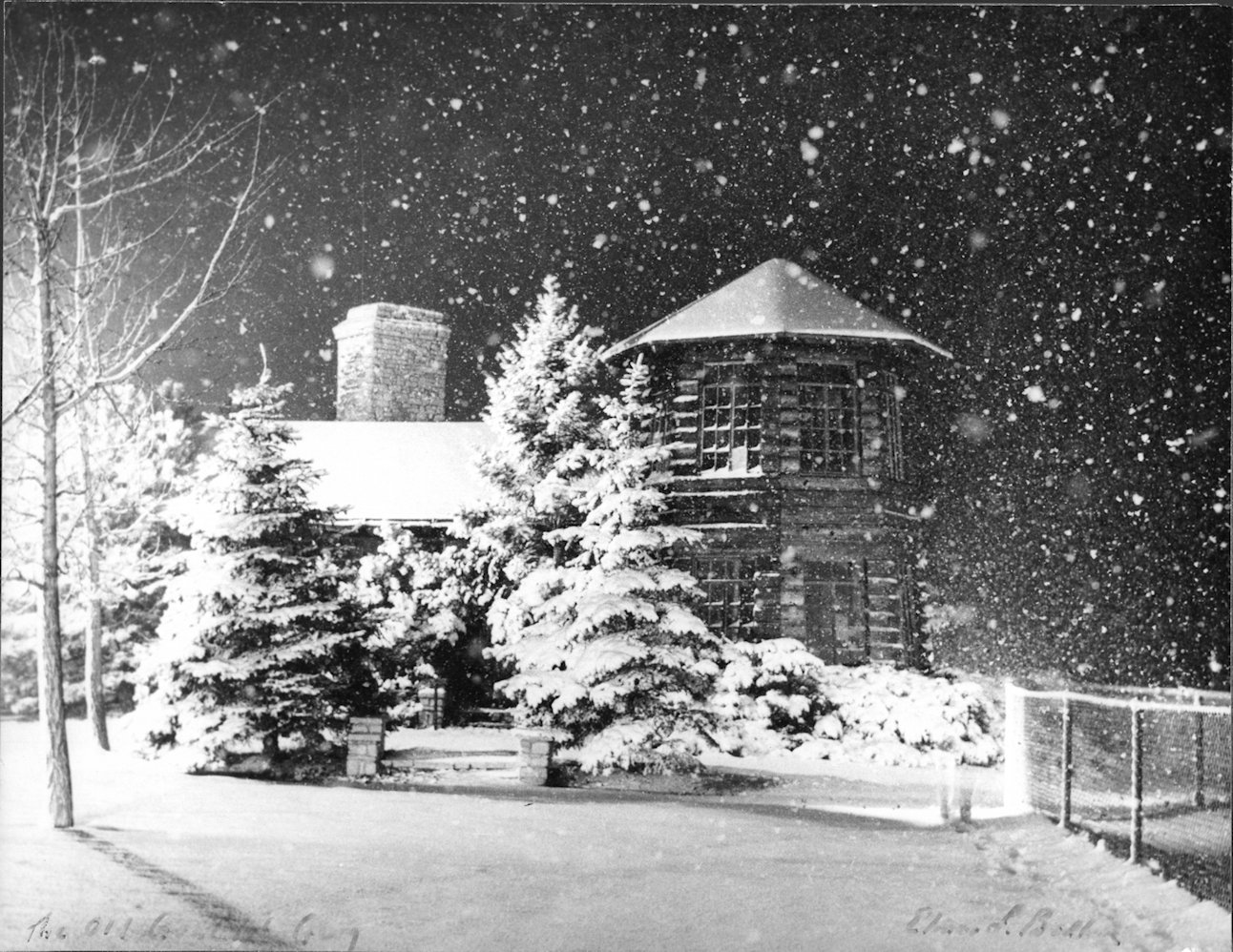
This fantastic winter picture of the club house in Marquette Park was taken by Frank Bohling.
This picture was taken
looking west while the 'post card' picture is looking more northerly.
Then, in February of 1936 the park board announced that it would build two more trap-shooting houses, making a total of four available for next spring. The bathers won out though, for in April the board voted to suspend shooting during the bathing season. The board also took action to begin construction of a $20,000.00 log cabin club house to be financed in part as a Works Project Administration project and part of the WPA's $332,000.00 park improvement program. In August the "Gary Municipal Gun club" met in the Pavilion to make plans for the fall and winter shooting program.
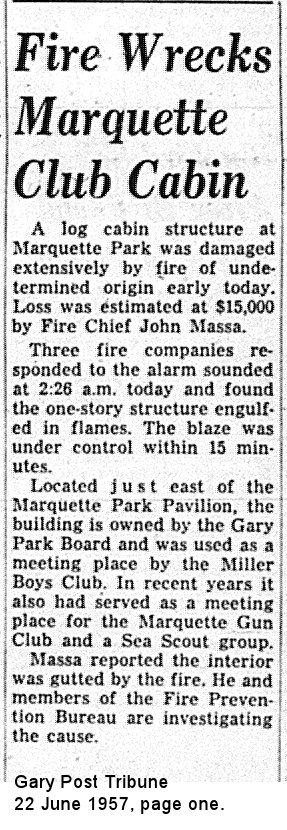
There is little in the press about shooting from then on, but doubt the range was used actively in the winter. One wonders how much World War II put a crimp in the availability of ammunition, but in any case the shotguns continued to be heard in Miller. In the 1999 fifty year Wirt High School reunion booklet, The Sands of Time, 1949-1999, it was written, "Shotguns were used for skeet shooting at the Marquette Park Gun Club and for hunting."
Having been used by the Marquette Park Gun Club, the Miller Boys Club, and a Sea Scout group, the club house, located about 700 feet east of the bath house, burned in June of 1957. "Fire of undetermined origin" in the papers, word around town, however, was that it was the work of an arsonist.
The Tolleston Gun Club
The Tolleston Gun club was the oldest, and very much the most famous, or infamous, gun club in the region. It was certainly the most written about, having precipitated a "range war" between locals and club members that resulted in several deaths.
On June 6, 1871 a special Michigan Central train left Union Depot in Chicago bound with about seventy Chicago luminaries for Tolleston to inspect and inaugurate the new club house which had been prepared over the spring. Among them was General Philip Sheridan of Civil War and Indian War fame and a man who would go on to become the ninth president of the National Rifle Association. The newly remodeled house was situated on sixty acres of land purchased by the club, about two miles from the railroad depot, and about three-quarters of a mile from the Little Calumet, "...right in the centre of the duck and fish region." (Chicago Tribune, June 7, 1871) The land, with the house, had been purchased in March with a contribution of $100 from each of the members of the new organization. Several articles appeared in the Chicago papers over the next decade extolling the picturesque location, naming in 1881 membership luminaries that included Marshall Field and George M. Pullman.
By 1893 the club owned twenty-three hundred acres within the some six thousand acres that had been purchased from the U.S. Government under the 1850 swamp land act. Vowing to fight its case all the way to the Supreme Court of the U.S., the club lost in court when the State of Indiana recovered the land in a decision of the Circuit Court of Lake County. Club president F.A. Howe declared, "We believe we own those lands and there isn't any power in Christendom that can dispossess us." Yet, after a decade of conflict with poachers the club's hold on its land came into question when the State of Indiana reclaimed the land which had been granted by the U.S. Government under the Swamp Act of 1850. Claims and counter-claims found their way into the courts, swamp land drainage, exodus of wild game, and encroaching "civilization" spelled the eventual doom of the club.
Poachers and Gamekeepers
The first decades of the club were, however, violent. While the club kept a gamekeeper and watchmen to keep locals off their land, the local men had long used that land for hunting, and food. The conflict escalated, never really dying down until the end of the century. In the 1920s, two decades or more after the events of 1890s, memory inspired accounts of the club appeared. However, two accounts written at the time by reporters provide perhaps more coherent accounts of the violence. Perhaps the most coherent is the article in the Chicago Tribune written in February of 1898 which I've provided transcribed. Another, written in November of 1899 in The Sunday Inter Ocean entitled "BAD RATS ARE THESE" recounts the murders and the "Muskrat Wars" in the Calumet marsh featuring some rather crude sketches but essentially is the same story as the Tribune article of the previous year.
Some of the other writings about the club:
- Kunert, William. "Early Days in Lake County - January 18, 1922" Indiana Magazine of History, Vol. 18, No.2 (June, 1922), page 173-173.
Kundert was superintendent of the Tolleston Gun club from 1889 to 1897. His father, Charles, was the first postmaster of Tolleston. - "Gives History of 25 Year Calumet Feud". The Post-Tribune January 12, 1923, page 13.
J. William Lester, then member of the Gary Historical society wrote a monograph, "The Poachers of the Calumet Swamps," for the Historical Society. The newspaper reprinted the story along with several photographs. - "'Frontier' Gun Club Fought Sportsmen." Gary Post-Tribune July 6, 1951, Second Section.
- Jamrok, Connie Sowa. "Indiana Badlands" Right Here 1987.
Anyone wishing to see or read any of the things in the above list please contact me. I have copies.
The above are documented formal clubs. Locals living east of Marquette Park today will tell you of houses which were originally "gun clubs." They no doubt were, but I expect that the cabins, now turned into homes, built in the decades before World War Two, were built to escape the heat of the summer and in the fall and winter were sometimes used as informal clubs of hunters.
Thanks to Joyce Davis of the Lake Street Gallery for the new picture of the Marquette Park club house.
Page created December, 2018; updated April, 2020 & October, 2021 © Text copyright: Steve Spicer
Feel free to contact me about this page.
